
It has been said so many times, "it came before its time."
More than a quarter century ago, the staid old Economist invented Tweeting. Of course, only a handful of people noticed (and I'm sure The Economist has forgotten all about it).
By the way, I have just joined Twitter and you can follow me (if you care) at rowlandr.
Back in 1981, I was working in London, at the Universal News Services PR wire and using Britain's fledgling Prestel videotex service. The Economist was also one of Prestel's clients.
In this early form of new media, you had a keyboard attached to a TV screen, which was wired through the phone system to a mainframe computer somewhere in an early version of cyberspace.
It was also expensive. You were not only paying for the phone line (at per minute rates) but in most cases (unless Prestel waived the charges) a per page fee as well. (So it never really got anywhere, a warning to those revisionist columnists who think the media should have started charging for access in the early days of the web).
The best way to get the news across was in short briefs. Not everyone did that, but The Economist did. If you wanted to print out a page, it came out on silvered, heat sensitive paper, with the type appearing only slightly darker silver. Hard to read, old chap.
And why do I remember all this? One story in the summer of 1981, reminded me of my home in "the colonies." It went something like this
There's good news and bad news from Canada. The good news is that the television network is on strike. The bad news is that the post office is on strike.(I make that 130 characters)
Ha ha ha. Yes there was a strike at the CBC at that time, And yes Canada Post was going through his infamous period of labour unrest.
The other stories were just like that. They were "tweets."
If they only knew what they started.........
Of course, The Economist is back at it. Twitter name The Economist and as of this moment there are 10,195 followers.
Technorati tags
writing, journalism, Twitter, Economist, videotex, Prestel,
Labels: CBC, Economist, London, Prestel, tweet, Twitter, videotex, writing
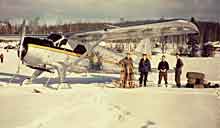 DHC-2 Beaver at Ootsa Lake, B.C. 1951-52
DHC-2 Beaver at Ootsa Lake, B.C. 1951-52A couple of weeks ago, I was going through old family pictures. There were baby pictures of me among the prints from that roll. Since I am planning to return to the parts of northern British Columbia where I grew up, I was looking for landmarks that would help me identify the places where I was little kid. Among the photos I found interesting were of some old planes, so I scanned the old prints at high res, and checked them out.
Turns out that I flew as a baby and toddler in one of the most famous aircraft in Canadian history, the original DHC-2 Beaver. And the story is now up on CBC.
The de Havilland Beaver and the birth of the bush plane
Technorati tags
writing, journalism, DHC2 Beaver, Ootsa Lake, De Havilland,Junkers W34, Kitimat,
Kemano, Central BC Airaways, bush plane, Alcan
Labels: British Columbia, CBC, DeHavilland Beaver, Junkers W 34, Kemano, Kitimat, Ootsa Lake

A brief pre-Christmas progress report on A River Kwai Story The Sonkrai Tribunal.
I spent the first couple of weeks of December going through what were once called (and perhaps still are in some ways) "the galleys." In the old days the galleys were the proofs were the long sheets of paper taken off long rows of metal ("hot") type. Later the galleys were the proofs that came out of some sort of electronic typesetting system.
These days it is Adobe's Acrobat system that is the standard, the complete book (all 6.5 megabytes) came to me by e-mail as a pdf attachment for that final check.
So it is now off to the printers (although the book won't be officially out until April, this was a good time to fit into the production schedule.
There is growing pre-publication interest in the book, with my agent looking at an offer for Asian English language rights and United Kingdom rights. Now perhaps an North American publisher will be interested as well.

I appeared live on BBC Radio Five this week (live from a CBC studio in Toronto) at 10:30 pm Toronto time, 3:30 am in the UK, for a 20-odd minute interview with Up All Night's host Rhod Sharp where we explored both the historic aspects of A River Kwai Story and the modern implications.
There is, unfortunately, no podcast of the show, and the onsite "aircheck" expired on Dec. 26.
Technorati tags
writing, journalism, Burma Thailand Railway, World War II, Iraq,F Force, Prisoner of War,
military tribunal, law, book
Labels: A River Kwai Story, BBC, Burma Thailand Railway, CBC, Geneva Convention, Guantanamo, Japan, Singapore, war crime, World War II, writing
Although many legal experts who have been discussing the case of Blackwater USA, the private contractor now being investigated for a shootout in Baghdad, say private contractors are in legal limbo, accountable to neither government nor laws, there is yet another episode from the Second World War in the Far East that is relevant to the modern world.
The guards in the River Kwai prison camps were gonzoku, private contractors employed by the Imperial Japanese Army. Many were tried as war criminals after war, including two of the defendants in A River Kwai Story.
Link to my story for CBCnews.ca
Private military contractors subject to rule of law
Second World War gonzoku provide precedent
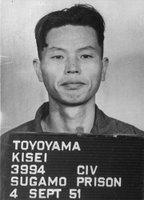
One of the main characters in A River Kwai Story is a Korean gonzoku or civilian contractor named Hong Ki-song, also known by his Japanese name Toyoyama Kisei, who was one of the most hated guards on the Burma Thailand Railway, and was notorious for beating prisoners of war with the shaft of a golf club. Toyoyama, who volunteered for the duty, was sentenced to death by a British military court in Singapore. That sentence was later commuted to life imprisonment. This mug shot was taken by the U.S. army in Sugamo Prison in Tokyo. (U.S. National Archives)
Technorati tags
writing, journalism, Burma Thailand Railway, World War II, Iraq,F Force, Prisoner of War,
military tribunal, Blackwater, law, book
Labels: A River Kwai Story, Burma Thailand Railway, CBC, F Force, human rights, war crime, World War II, writing
CBC technology blog post How about a HDTV with that DSLR?
It begins with my first SLR.
When Minolta made the announcement that it was going out of business, I wrote a longer version of my experiences with Minolta in my blog post The End of the Minolta Era.
Here's a slightly updated summary:
My father gave me my first SLR, a Minolta SRT 101 for my 18th birthday many years ago.
That camera took me right across Canada in the summer of 1969 from Montreal to Victoria, across Canada to Halifax and then back to Montreal. I was part of the first Aventure Canadienne, one of Pierre Trudeau's first experiments in bilingual and bicultural exchange, twenty students, half Anglophone, half Francophone going across Canada in two blue minibuses.
I used the SRT 101 in journalism school and on my first job as a reporter/photographer on the Sudbury Star, and then I took it across Europe a year later. I took the SRT 101 with me for the year I worked in London,where it survived being tossed across a room by a crazy landlady.
In the early 1980s, bought the Minolta X700 just before I moved into broadcasting and used that camera for years...mostly landscapes since I wasn't shooting journalism at that time.
For video I used a Sony Hi8 camera to shoot my documentary for CBC's Pacific Rim report on my trip up the River Kwai and later bought a Sony DV camera).
I bought a Minolta Maxxum 4 around 2000 or so and added a Sigma zoom and a Minolta 50mm.
At the time when Canon and Nikon and other camera companies were going big on high end, professional digital, Minolta stood still--one reason they got into to business trouble.
I probably would have switched to Canon except for the fact that in October 2005, Minolta Canada went out of business before the company's other branches which closed down in January 2006.
That meant the retailers here in Canada wanted to dump their Minolta cameras and lenses (they didn't foresee the deal where Sony bought Konica-Minolta digital camera technology and patents)
So I got the 7D for $1000 instead of $2000, got a better mid range zoom and a wide angle and a flash --all at less than half the price it would normally have cost.
It appears that elsewhere around the world no one dumped Minolta lenses at fire sale prices after the Sony deal was announced-- the retailers knew the lenses were good for the upcoming Sony cameras.
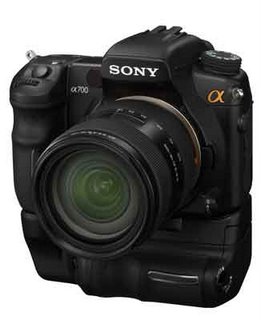
So I have now all this equipment and most of it is compatible with the Sonys--and if, from time to time, I want to shoot film, most of the lens and equipment will work with the Maxxum film camera. So I am going to stick with cameras I know, know how to operate and like using.
I didn't have much time last Thursday for the hands on session with the Alpha 700. You will find a review from Doug Brown on the DPreview forum here.
Among the features that stood out for me in the Alpha 700 were:
The presenters were pushing a function key system that means you don't have to stop and look at the menu in midshoot.
Both in the PR book and the presentation Sony said the in camera image stabilization system is made to work with any lens--in other words all the Minolta lenses out there just waiting for a new digital camera.
Some of the "new" features were on the Minolta 7D which I use such as the auto focus/manual focus button.
One feature I found interesting is a white balance bracketing setting, three frames at different WB settings, could come in handy if you are shooting jpg in an unusual lighting situation.
Offers an optional vertical grip with a second battery with automatic switching to the second battery when the first gets low.
Shoots 5 fps -doesn't match the Mark III's 10 fps.(although Brown was told Sony was working on improving this).
Offers something called cRAW which compresses the RAW setting by 30 per cent.
Continuous shooting capacity is 18 frames RAW, 25 frames cRAW and 16 frames extra fine jpg, looks like the continuous mode is optimized for cRaw.
Doug Brown's review also said the Alpha 700 is the only DSLR on the market at the moment that shoots in the 16:9 aspect ratio. That will be a great advantage for me because broadcasters are now shooting mostly 16:9 as part of the transition to high definition and I am already shooting 16:9 assignments using my Lumix FZ50 point and shoot.
Sony Canada news release.
Technorati tags
photography, journalism, Minolta, Sony, Alpha 700,CBC, 16:9,
photojournalism
Labels: Ajpha 700, CBC, HDTV, Lumix, Minolta, Panasonic, photography, photojournalism, Sony
I covered the Canadian launch of the new Sony Alpha 700 digital single lens reflex camera today, Thursday, Sept. 6, 2007.
You can read my story on the CBCnews.ca technology blog. The Sony A700 is not the new pro model some people were expecting. But it can come with a high definition television.
How about an HDTV with that DSLR?
Technorati tags
photography, journalism, CBC, Sony, HDTV,
Labels: CBC, HDTV, Minolta, photography, Sony
Which brings me to Ernest Hemingway's lost blog (or what would have been a blog if there had been a computerized world when "Papa" was writing.)
Most people know about Hemingway's famous lost short stories. In 1923, Hemingway's first wife, Hadley Richardson, was travelling from Paris to Lausanne to meet Hemingway and as she was waiting for a train at the Gare de Lyon, the suitcase with the stories was stolen from the station platform and so the stories were lost to literature and history. (Make a backup Ernest! Use carbon paper!)
The other lost work by Ernest Hemingway is less well known, his resignation letter from the Toronto Star. According to a number of Star histories, when Hemingway got fed up and decided to quit, he wrote a eloquent denunciation of The Star and its management on a long piece of paper taken from a teletype roll. (anticipating Jack Kerouac's method in On the Road by 30 years).
Imagine what it would have been like then if Hemingway had blogged? Now since it was a resignation letter, it wouldn't have broken any employee's blog restrictions, but that work, either on a blog or on teletype paper, would have likely have been the one the great documents in the history of journalism.
Hemingway apparently pinned the long sheet of teletype paper to a Star bulletin board and it remained there for months, and the staff kept reading it, loving it (one wonders what Star management thought) until one day it fall to the floor and was was swept up by the cleaning staff and ended up in a Toronto landfill.
I have had this website since December 26, 1999 (the date I registered robinrowland.com). It was created to promote my books and to put up the course outline and hints for my students when I taught at Ryerson University of School of Journalism. At that time, a few CBC employees had personal sites and when I started the site there was no objection, in fact I was told it was a great idea.
I posted my first blog entry on October 18, 2004, to track and promote the book I was writing at the time now called A River Kwai Story. Again, at the time, I was told it was a great idea.
Except of the time during the lockout, I have kept my blog tightly focused on my book project and on my photography along with occasional personal stuff.
But what do these guidelines say? That I can't talk about the brands of cameras I use, developments in the world of digital photography or the quality of my photo quality ink jet printer? As I do here and here and here and here. Is that endorsing (or not) a product?
A River Kwai Story is based on my academic research for my Master's Degree and it's about the history of war crimes and military tribunals. It could be, in some circles, be considered controversial. Does that mean CBC employees can't write controversial books--even if the work has done completely on their own time and has nothing to do what happens inside the corporation? (And for the record, stories based on my research have been offered to CBC News from time to time)
Which brings me back to Ernest Hemingway. If he was writing today, Hemingway would have to have a blog to promote his books, it is an absolute necessity in the 21st Century. Hemingway would have had to have a blog whether he worked for The Star or was an independent freelancer. I am sure Hemingway would use a blog as an outlet for his talents and ideas that might now, in the modern world of beancounting publishing, have no other outlet, even if the name of the author is Ernest Hemingway.
The problem is that most of the CBC employees who openly blog under their own names have been known from before the lockout. A year ago some of us issued the CBC Blogging Manifesto and signed our names to that document. It would have been easy to call a meeting and discuss these guidelines with the bloggers. I wasn't consulted and as far as I know, no other blogger was either.
Paul has quoted what the late CBC Ombudsman David Bazay said about blogging
If public broadcasters are to become bloggers I would hope that they would exercise their freedom of speech exactly the way they are compelled to exercise it within the CBC: with accuracy, fairness and integrity, with the responsible speech of CBC’s Journalistic Standards and Practices that has helped make this place one of the great places in the world where the citizen can be well informed.
I thought at the time that Bazay was right on and I have followed those guidelines.
If any corporation anywhere, respects its employees, that is all that is needed.
Technorati tags
writing, journalism,book, blog,blogging,
Labels: A River Kwai Story, blogging, CBC, Ernest Hemingway, news, publishing, research, Toronto Star, writing
At the same time, the Australian publisher, Allen and Unwin, has postponed publication a second time, so instead of 2007, it is now scheduled for late April 2008, to coincide with Australia's ANZAC Day. The book had been scheduled for July 6, 2007, but there were delays in the editing process.
It appears from what I am told, that unlike in North America, where the major selling period for books is around Christmas, publishers Down Under consider Christmas to be one of the worst times to sell books, except, as I was told "children's books and large novels." I am guessing it is maybe the weather, here everyone bundles up and reads through the winter, in Australia, I guess, they all go to the beach.
Also the book will not be available on Amazon, or any other online retailer. I had hoped that I could make up for the total lack of interest by North American and British publishers with sales on the major online retailers. That apparently is not possible, since Allan and Unwin only purchased the Australia and New Zealand rights, they can't put it up on Amazon.
Now, after I get the galleys (early September I hope) perhaps my agent can kindle some interest somewhere.
One online bookstore in Queensland is advertising the book. So you can order it from QBD The Bookshop, an online bookseller in Australia, which does ship internationally. Prices are in Australian dollars.
Link to order A River Kwai Story from QBD The Bookshop
So what are my plans? This project has taken more years than I ever expected. It was in July 2000 that I was admitted to the Interdisciplinary Masters Program at York University and Osgoode Hall Law School. I defended my thesis in September 2003 and graduated in November 2003. It took me six weeks, part time, to write the thesis. But it took more than two and a half years to write the book. It took longer than I expected to turn the academic argument into a narrative. And then, as mentioned earlier in this blog, publication was postponed last year.
So I while I have a few other ideas on my hard drive, I am not going to write a word, outside of work, until the book comes out. It's time to catch up on things I have put on hold for the past seven years. Let's hope that the next seven will be good ones.
Technorati tags
writing, journalism, Burma Thailand Railway, World War II, Australia,F Force, Prisoner of War,
military tribunal,POW, book
Labels: A River Kwai Story, Allen and Unwin, Australia, Canada, CBC, human rights, writing
This just posted on CBC.ca/news
Alberto Gonzales and the Geneva Convention.
Did the president's lawyer misread the Geneva Convention?
Did Alberto Gonzales, the embattled attorney general of the United States, turn a blind eye to legal history when he wrote a memo to President George W. Bush back in 2002 suggesting ways to avoid the Geneva Convention?
Although my book, A River Kwai Story The Sonkrai Tribunal is largely about the Second World War, it is also about the Geneva Convention and the inhuman treatment of prisoners of war.
So when I was doing my research for the book and I read a key phrase in a memo written January 25, 2002, from Gonzales to President George Bush (and leaked when the Abu Ghraib scandal broke) that said.
. . . some of the language of the GPW [Geneva Convention on Prisoners of War] is undefined (it prohibits, for example, ‘outrages against personal dignity’ and ‘inhuman treatment’) . . .
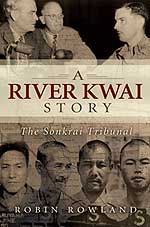 I was, to say the least, surprised, since almost all the Far East war crimes trials for the abuse of prisoner of war, charged or contained the phrase "inhuman treatment."
I was, to say the least, surprised, since almost all the Far East war crimes trials for the abuse of prisoner of war, charged or contained the phrase "inhuman treatment." How could the counsel to the president of the United States ignore the suffering of several hundred thousand Allied prisoners of war, including thousands of American POWs?"
It may take many years of history to answer that question.
The CBC news story outlines what Gonzales should have known when he wrote that memo.
The book, of course, will tell the reader, the exact details of the "inhuman treatment" carried out by the Japanese against the men of F Force.
Technorati tags
CBC, journalism, Burma Thailand Railway, World War II, Australia,F Force, Prisoner of War,
military tribunal, Alberto Gonzales, POW, Geneva Convention
Labels: A River Kwai Story, Alberto Gonzales, Burma Thailand Railway, CBC, Geneva Convention, Guantanamo, human rights, Singapore, United States, war crime, World War II
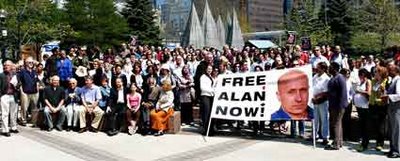
Hundreds of journalists and other supporters rallied at Toronto's Simcoe Park on Thursday May 10, 2007, to support kidnapped BBC journalist Alan Johnston, who by that time had been held in Gaza for 60 days.
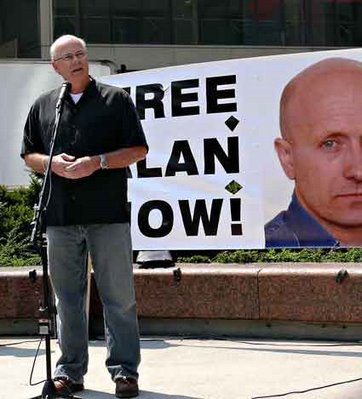
CBC Chief Correspondent Peter Mansbridge expresses his support for Alan Johnston and his family at the rally.
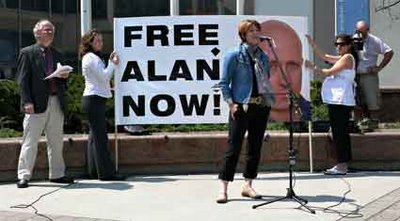
Host of CBC's The Current, Anna Maria Tremonti, a former Middle East correspondent, spoke about Alan Johnston's reporting from Gaza. Former BBC correspondent Daniel Lak who helped organize the rally is on the left.
CBC News story on the rally at Simcoe Park
CBC Editor-in-chief Tony Burman's letter calling for freedom for Alan Johnston
Sign the BBC Online petition
BBC "How You Can Help"
Toronto Star Canadian media protest kidnapping
Canadian Press story on Canoe
Daniel Lak's blog, Lakwords
Technorati tags
writing, journalism,
BBC,Alan Johnston, Gaza,CBC
Labels: Alan Johnston, BBC, Canada, CBC, Gaza, photography, Toronto
In Toronto at
Simcoe Park
200 Front Street West
(beside the CBC building)
Thursday, May 10, 2007
12:00 p.m. - 12:40p.m.
Speakers include:
Peter Mansbridge, CBC Television
Brian Stewart, CBC Television
Anna Maria Tremonti, CBC Radio
Rick MacInnes Rae, CBC Radio
Patrick Martin, The Globe and Mail
Sandro Contenta, Toronto Star

Click in the image link above or go to the BBC Editor's page on Alan Johnston.
Johnston, 44, is a veteran foreign correspondent. Before moving to Gaza in 2004, he ran BBC bureaus in Kabul and Tashkent. He is widely respected and liked by his peers. His reporting on events in Gaza has been widely acclaimed as balanced, insightful and courageous.
The BBC and media workers rights organizations around the world have been calling for Johnston's immediate and safe release from the day of his abduction. These appeals have taken on a new urgency as time goes on. His parents in Scotland, both in their 70s, have appeared on international television and radio to appeal to his kidnappers for their son's freedom.
Johnston is believed to be alive and in good health but there is no sign of his captors releasing him anytime soon. Why he's being held remains a matter for speculation.
A single media worker harmed or kidnapped is one too many. The International Freedom of Expression eXchange (IFEX) reports dozens of instances of journalists taken hostage each year, many of them in Iraq and the Gaza strip. Fourteen journalists have been kidnapped in the Gaza Strip since 2005. Reporters, camera crew and producers need to know they can work safely in troubled areas like Gaza. If journalists are unable to report freely, the world will have lost vital access to information.
CBC News Editor in Chief, Tony Burman's Letter: Why BBC's kidnapped Alan Johnston needs to be freed.
Technorati tags
writing, journalism,
BBC,Alan Johnston, Gaza,CBC
Labels: Alan Johnston, BBC, Canada, CBC, Gaza, Globe and Mail, news, Toronto, Toronto Star, writing
My CBC colleague Paul Gorbould of our online Archives reveals one of the secrets that Google is using to create its controversial Google Book Search, by turning high-end Nikons into a robotic scanner.
It's from a company called Kirtas, and has a total cost of about $200,000.
Details on his blog in a post called Speed Reader.
Reminds of the old sayings about using a racehorse to pull a cart.
But at least using the Nikon will likely ensure the result is readable!
As the New Yorker reported this week Google wants to scan every book ever published and this has been controversial ever since it was announced. Legal expert Jeffrey Toobin says in the story Google isn't the only outfit planning to scan every written word from Gilgamesh to Harry Potter.
Gilgamesh, at least in the original cuneiform, if you can find a copy that is not copyrighted by a museum, should have been in pubic domain for 4600 years. Harry Potter, of course, will remain copyrighted for years after the latest Harry Potter and the Deathly Hallows hits the streets in July.
And Google recently announced plans to merge Google Maps with Google Books, so, in theory, you can follow your character, fiction or non-fiction, through the streets of New York or Moscow. Although I wonder how Google Book-Maps would handle the settlements in Robert Heinlein's Moon is a Harsh Mistress
(Wikipedia entry)
I now have a "what do I have to lose" attitude about Google Book Search, especially since Toobin's article shows that the publishers are of two minds (or perhaps forked tongues) on the issue, at one end making deals with Google and on the other suing over copyright issues.
Ever since book publishing became part of media conglomerates and began selling books to the major chains, rather than the reading public, the author has become the least important person in the process. I simply assume--and most writers I know agree with this--that I am going to be ripped off anyway. So what's a little copyright infringement along the way? Perhaps if Google finds a way to pay the author's share directly for those who want to view or download copyright works, rather than going through the publishers, there will be more pluses than minuses for an author.
It's often less frustrating and more satisfying just to blog at least part of your work without having to deal with magazines that won't pay you enough for your time and effort any way or editors who write "guidelines" which are so unclear that they could have used a good copy editor. That's why I am blogging how I am building my model railway, rather than bothering to go to the magazines, which demand all rights --another ripoff.
Labels: CBC, Google, Google Book Search, Harry Potter, photography, publishing, Robert Heinlein, writing
A number of newspaper managers around the world, apparently desperate to keep their corner offices in the uncertain and unsettling world of the digital convergence are predicting the end of the still photo camera.
Some photographers, the "early adopters" are also jumping on the band wagon.
The photo is dead. Long live video they say.
They're wrong. They're throwing out the baby with the developer bath water. A sort of mixed metaphor, especially for the age of digital photography, but I hope it makes a point.
EPUK, the website for the Editorial Photographers United Kingdom and Ireland, in a story last fall, that I just came across, quoted the newly appointed Executive Editor (Pictures), Stuart Nicol, of the Daily Telegraph as saying:
“Digital stills photography will, when we look back on it, form a very small period of time in the history of photojournalism”, Nicol told EPUK. “Telegraph photographers will undoubtedly be shooting solely on video in the future, and certainly within a year we hope to be well advanced down that route.”
The article goes on to say
At the moment the quality of video stills available from small video cameras is generally below that needed to produce photographic quality. However, some US newspapers including the Detroit Free Press and Dallas Morning News have already begun shooting solely on video, at 1920×1080 pixel resolution, on cameras costing around $5000, equivalent to a high-end digital SLR body
You have to use the new High Definition cameras.
In this post on MultiMedia shooter there is a tutorial on how it is done.
I would also note that while many newspapers are adding video to their pages (just as television stations and networks are adding still photography) and both the Associated Press and the Canadian Press offer video for member websites, the quality when it is shot with a still camera or when processed just for the web is so poor that it cannot be used for broadcast unless it is the only video of an important news story.
In my view, and I have the experience, while video frame grabs can be good, there is no substitute for the still photographer and there never will be. There will still be photographers shooting stills with still cameras long after Mr. Nicol has retired from the Telegraph.
(And in checking the site, I couldn't find any images that looked as if they came from an HDTV video cam)
Shooting stills and shooting video are like two brothers or sisters. Same gene pool but different people.
For more than 10 years how, I have been grabbing frames from CBC News video for use on the CBC.ca website. I discovered very early that the trigger finger process used for on the fly frame grabs never produces a good still frame. For a good picture, you have to capture a section of the video and examine it frame by frame until you find one that has the potential for a good still picture.
If you find that one frame that captures the decisive moment and has great composition and framing and colour, you can get a good picture. But remember, at this point, with NTSC, with 515 lines,and PAL with between 575 and 625 lines, depending on the local standard, and a maximum capture of 720 x 540 pixels, you're talking the equivalent of a one megapixel camera.
The best High Definition frame is 1920 x 1080, which would roughly be the equivalent of a three to four megapixel still camera, although from what I saw from an briefing on future software developments by Adobe last fall, the fact the HDTV capture is digital does give the photo editor more to work with.
For a fast paced, money conscious news organization, the bean counters will quickly find out that it is faster for an experienced professional photo editor or photographer to scan the frames shot from a still camera with modern software and pick out the best pictures. In fact, it is highly likely that a photo editor could choose, process and send to the web or the layout desk a still picture before the video was captured and a good frame chosen for use.
Let's just give two examples where the difference between video and still photography is seen the most:
1)Speakers. A TV photographer shooting a speaker is recording the best clips. A still photographer recording the same speaker is looking for the decisive moment in the speech. You have the same moment, but the aim of the shooter is different.
The video camera records the movements of the face. In going through a series of captured frames, each frame will have a different moment of human expression.
The most difficult job in grabbing frames is not just finding a good picture, often it is finding the frame that doesn't make the speaker look an idiot, whether president or prime minister, mayor or police chief, cop on the scene or heroic kid (the politicians may be idiots but a frame grab is not the time to point that out.)
The still photographer can always do it better.
2. Action. The video shooter is looking and following the action. The camera is often moving. The current television camera captures at 30 frames per second, film at 24 frames a second and HDTV can capture at between 24 and 60 frames a second, depending on how the video is going to be used.
That means that even an HDTV camera cannot capture at any faster than 1/60 of a second. So whether it is football game, a wildlife shot or action on the street, a still photographer shooting at anywhere from 1/125 of a second to 1/1000 of a second can capture the action better. The problem is that when you look at a current NTSC frame, captured at 30 frames per second, 1/30 of a second, the action is blurred. Your eye doesn't see it on the TV screen, but it is there on the frame. You may get lucky and get the one frame that does capture the action-- I was able to do that last year with an Olympic skiing shot from the CBC broadcast that was requested by Canadian Press and run in papers across the country.
More likely you are going to get the face or the arms or the legs or the running back or the speeding car all jaggy, the equivalent of the photo blur. The only solution is to try multiple passes at deinterlacing in PhotoShop and even then it is not perfect.
The bottom line is that these are two different technologies. I have excellent 13" x 19" prints from pictures from my first 2 megapixel camera, so I am not saying it can't be done with an HDTV cam. But with the standard for consumer still cameras now at 10 megapixels, it is unlikely we will see the end of the still photographer anytime soon.
Want to compare still photos and well-processed NTSC capture images? Go the photo gallery I produced of the storm wrecked West Coast Trail on Vancouver Island, Paradise Lost, click on Open in Full Screen and see the difference between a photograph and an NSTSC screen grab.
Labels: CBC, Daily Telegraph, HDTV, news, NTSC, PAL, photography
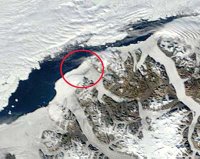
Sometimes last week, I wondered if I was living in a science fiction novel or movie. I've been reading science fiction since I was a kid. Only it wasn't the great adventure into space, it could be the opening scene of a disaster story.
On December 28, 2006, the Canadian media, including the CBC reported a discovery by Laurie Weirs of the Canadian Ice Service. She had found, by looking at NASA satellite images, that the Ayles ice shelf had collapsed on the northern tip of Ellesmere Island back in August 2005. (official report on the collapse).
Weirs' discovery was confirmed by Luke Copland at the University of Ottawa Laboratory for Cyrospheric Research. You wll find his special website on the event here.
The story was picked up media around the world.
My colleagues at CBC's Quirks and Quarks also reported on the even on January 6, 2007. You can find and listen to an MP3 of the broadcast by clicking the link.
Once I got back to work after the New Year, I spoke to both Weirs and Copeland. At CBC.ca, we decided to build a photo gallery that would track the collapse. The first images used in the study were from the NASA/MODIS real time images from the Terra and Aqua satellites and uncorrected for the curvature of the earth.
So I called my contacts at the Goodard Space Flight Center, where the MODIS project has its headquarters and requested images corrected for the curvature of the Earth for use in the photo gallery. MODIS reported the ice shelf collapse on January 9. 2007.
The images were used in the CBC photo gallery which tracks ice shelf collapse minute by minute.
The CBC's Kelly Crowe also did a follow up report for the National. (Real Video, runs 5:24).
So no wonder there were those science ficton movie thoughts in the back of mind, getting those satellite images from NASA of yet another indication of global climate change. Is it the opening scene of what is to come.....?
Labels: Arctic, Ayles Ice Shelf, Canada, CBC, climate change, Ellesmere Island, NASA
The CBC has obtained video showing that the government of Myanmar (Burma) is using forced labour to build roads through the jungle in some areas close to where the Burma ThailandRailway once ran.
The documentary by our Asia correspondent Patrick Brown was broadcast January 8, on the CBC National.
A couple of excepts from the script
It's being documented by a group of courageous young Karens who take video cameras in to the war zone and bring back the pictures which show the world what's happening there... Pictures of the strongest evidence of human rights abuses in what's been called the Forgotten War. In Burma itself, just being caught with a camera would mean prison or even death.---
PATRICK BROWN (REPORTER):-
The Burma issues' video team took enormous risks to film this extraordinary evidence of villagers being forced to build a road for the Burmese army.
UNIDENTIFIED KAREN MAN:
(translation) Grandma, how much are you paid for each load of stone?
UNIDENTIFIED KAREN WOMAN:
(translation) I don't know about that.
UNIDENTIFIED KAREN MAN:
(translation) Are you paid for working here?
UNIDENTIFIED KAREN WOMAN:
(translation) No.
-
You can watch the video (which is about 23 minutes in total) by
going to CBC.ca/national and finding the documentary "A Better Tomorrow." (requires Real Video or compatible player)
Labels: Burma, Burma Thailand Railway, CBC, Myanmar



